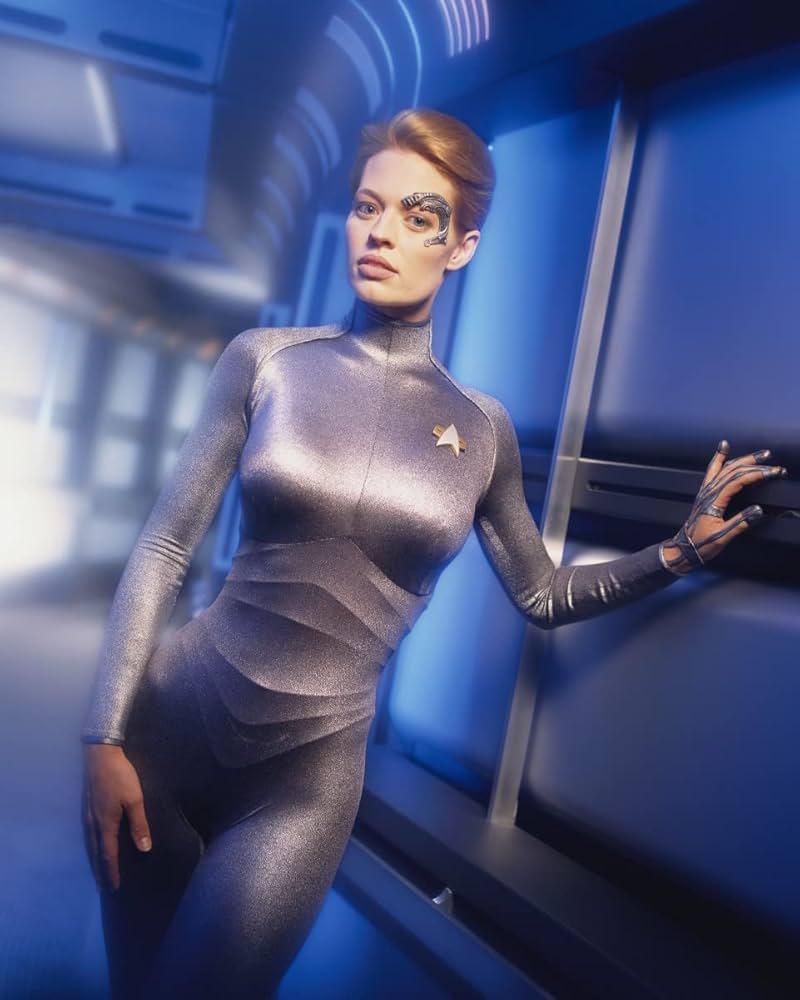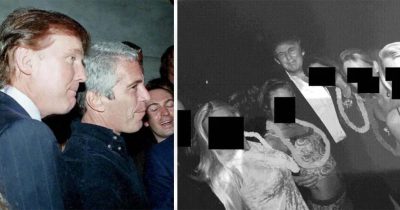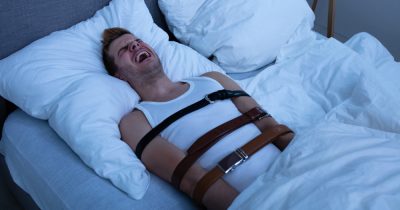
They may have hired Jeri Ryan for her beauty, but Seven of Nine turned out to be one of the best characters in the entire Star Trek franchise.
Watching her walk around Voyager in her body suits was kind of mesmerizing – but her character was really interesting, too.
But did you know she had a secret enemy on set?
The game behind Jeri Ryan’s success
When Jeri Ryan stepped onto the set of Star Trek: Voyager in 1997, the show was teetering on the edge. The ratings were slipping, the stakes were high, and the producers knew they needed something — or someone — to turn things around. Enter Seven of Nine.
A former Borg drone severed from the Collective, her character was a fusion of cold precision and buried humanity, a puzzle waiting to be solved.
And when she appeared in season four, the effect was immediate. Ratings skyrocketed — by a staggering 60%. The network had gambled on her, banking on her striking presence to pull in viewers. And it worked.

But what they might not have anticipated was just how good she truly was. Not just a mesmerizing figure in a skintight uniform, but an actress of remarkable depth. She didn’t just play Seven; she became her, layer by layer, letting glimpses of vulnerability slip through the steel.
One episode, in particular, stands out—one where Seven, fractured by a cascade of personalities, shifts from one identity to another in rapid succession. It was a performance that should have earned her an award, a showcase of sheer talent that transcended the show’s sci-fi trappings.
They hired her to save Voyager. What they got was something far greater.
Why she turned down the role four times
Jeri Ryan, born Jeri Lynn Zimmermann on February 22, 1968, in Munich, West Germany, moved to Los Angeles after college to pursue acting full-time.
In 1997, she was relatively unknown when the creators of Star Trek: Voyager set their sights on her for the role of Seven of Nine. Surprisingly, Ryan turned down the part not once, but four times.
But, why didn’t she want to join? In a January 2020 interview, Jeri Ryan revealed that when producers first approached her about Star Trek: Voyager, she had never seen the show. Curious, she decided to watch an episode — and quickly regretted it. She described it as “the worst hour of television” she had ever seen.
”They gave me a copy of First Contact, the movie, so I could at least see what a Borg was. They also gave me a copy of the Big Star Trek encyclopaedia, whatever it is, so that I could bone up on my Star Trek knowledge,” Ryan explained.
It was only after relentless persuasion from executive producer Jeri Taylor that she finally agreed to take on the iconic role as Seven of Nine, a Borg drone who was freed from the Borg’s collective consciousness.
The fight the camera didn’t catch
Jeri Ryan would feel it before the cameras even rolled — a knot of anxiety tightening in her stomach at the mere thought of sharing a scene with co-star Kate Mulgrew. It wasn’t nerves. It wasn’t stage fright. It was something heavier, an unspoken tension that hung in the air whenever they worked together.
Most of the Voyager cast had noticed it. The friction between them wasn’t just rumor; it was real, and for years, it remained unresolved. Ryan, the newcomer, had been thrust into the spotlight as Seven of Nine, the undeniably striking former Borg drone. Mulgrew, the show’s seasoned lead, had spent years crafting Captain Janeway as a strong, independent figure, resisting every attempt to shoehorn her character into a romance. And now, suddenly, all eyes were on Seven.
For Mulgrew, it wasn’t personal — at least, not at first. She had wanted to shift Star Trek away from overt sexualization, to make it about intellect, leadership, and exploration. But the network had other plans. They had brought in Ryan, a beautiful and undeniably sexualized character, to revive the show’s ratings. And it worked.
The strain between them lingered for years, a quiet storm beneath the surface. Ryan kept her head down, delivering performance after performance, while Mulgrew wrestled with her own frustration.

In time, though, something changed. Mulgrew, with the wisdom of hindsight, saw the bigger picture. She later admitted her resentment, acknowledged how difficult she had made things for Ryan, and owned her part in their troubled dynamic.
And then, she did something unexpected — she apologized.
“You did a marvelous job in a very difficult role,” she told Ryan. The past was the past. The tension, the cold looks, the unspoken frustrations—it was over.
Since then, they’ve shared the stage at Star Trek conventions, laughing, reminiscing, and proving that even the deepest rifts can be healed. Looking at pictures from today, it’s quite hard to believe these two didn’t get along on set?
She burned her own catsuit
Seven of Nine’s iconic catsuit may have looked sleek and futuristic on screen, but behind the scenes, it was a nightmare. Seven of Nine’s corset was so tight that Jeri Ryan struggled to breathe while wearing it. Between takes, she often had to lie down just to regain her breath before stepping back in front of the camera.
And the skintight, one-piece design meant Jeri Ryan couldn’t get in or out of it without help from the costume department. Since the suit was a one-piece with no zipper, Jeri Ryan had to be sewn into it every time she wore it, and getting out of it was no easy task
Even something as simple as a bathroom break turned into a time-consuming ordeal, forcing her to “hold it” for long stretches just to avoid delaying filming. A simple bathroom break on set turned into a 20-minute ordeal, which led to her own radio code: “Code Jeri-Twenty.”
Ryan’s frustration with the outfit grew over the years, and by the time Voyager wrapped, she had only one thing left to do — get rid of it for good. With no hesitation, she burned the costume, making sure she would never have to squeeze into it again.
The invisible Wall of Shame
On the set of Star Trek: Voyager, where the magic of sci-fi meets the absurdity of pretending, actors often found themselves engaged in the fine art of “force field acting” — a skill that required throwing oneself against absolutely nothing and making it look convincing.
Take, for example, the infamous moment in The Gift, one of the early episodes featuring Seven of Nine. With all the seriousness of a Starfleet officer facing imminent doom, the actor had to hurl themselves at the brig’s force field — except, of course, there was no force field. No shimmering energy barrier. No resistance. Just the cold, unfeeling air of a soundstage.
”You do a lot of acting to nothing, because there is a lot of special effects, so you’re acting on a green screen or a blue screen, which means you’re acting to nothing and reacting to nothing,” Ryan once explained.

The result? A spectacularly awkward performance where they flung themselves forward, only to stop mid-motion, arms flailing, face contorted in mock pain — while the crew tried (and sometimes failed) to stifle laughter behind the camera.
”Force field acting” quickly became an inside joke. It wasn’t just about selling the illusion — it was about doing it with a straight face while knowing that, in reality, you looked absolutely ridiculous.
But that’s the magic of sci-fi. One day, you’re battling intergalactic threats. The next, you’re throwing yourself at nothing and hoping the CGI team has your back.
What did Seven of Nine stand for in Voyager?
If you ask Jeri Ryan herself, she has plenty to say about the character she grew to love.
Seven of Nine wasn’t just another addition to the crew—she was a force of change. Before her arrival, Voyager had settled into a comfortable rhythm. The tension between Starfleet and the Maquis had faded, leaving little internal conflict. Everyone got along. Too well, perhaps.
But then came Seven. A former Borg drone, severed from the hive mind and forced to navigate individuality for the first time. She wasn’t just a crewmate; she was a challenge. A disruptor. And that, Ryan believed, was exactly what the show needed.
Looking back, Ryan has reflected on what made her character so important, not just to the series but to the broader Star Trek legacy.
”Humanity, in general, was one of the things Seven allowed them to explore,” she reflected. “She brought conflict to the show — something that was sadly lacking. Once the Maquis made up with Janeway and company, it was just one big happy family.”
But it wasn’t just conflict that made her addition so compelling. Seven of Nine fit into a classic Star Trek archetype: the outsider who forces humanity to examine itself. Much like Spock, Data, or Odo before her, Seven provided a unique lens through which the series could explore deep philosophical questions about identity, morality, and free will.
Why Seven of Nine wore high heels
Ever wondered why Seven of Nine strutted around Voyager in high heels? Fans have debated the practicality of it for years, but Jeri Ryan has a simple answer: everyone wore heels!
“All the female characters wore boots with heels,” she explained. “And if you’re going to walk around in a body stocking, I want to see you pad around in flats—it’s not happening!”
The heels weren’t necessarily a character choice, but rather a design decision to create a sleek, elongated silhouette.
So while it may not have been the most practical footwear for a former Borg drone, it certainly made for an unforgettable look.
The hidden challenge of playing Seven of Nine
We know that Jeri Ryan’s Star Trek: Voyager costume was one of the toughest parts of her time on set. But there was another challenge — one that isn’t as obvious when watching the series but becomes amusingly clear when looking back at behind-the-scenes photos.
Keeping a straight face.
“The two biggest challenges with Seven were keeping a straight face and working with all those guys who were absolutely nuts,” Ryan once admitted.
Seven of Nine, for all her Borg precision and stoic demeanor, was still human. She had emotions — just like everyone else — but she lacked the ability to express them. More than that, she was terrified to. Every feeling was carefully locked away, hidden beneath a surface of calm detachment.
“There’s a fine line between being unemotional and showing too much,” Ryan explained. “That challenge was really fun to play as an actor.”
And yet, in the middle of all this restraint and subtlety, she was surrounded by a cast full of pranksters. While Seven stood rigid, delivering lines in her signature controlled tone, chaos was often unfolding just out of frame. Keeping a straight face in the middle of it all? Easier said than done.

Despite the difficulty, Ryan has often described Seven as one of the greatest roles of her career. “This character really was a gift as an actor,” she said. “Everything was new to Seven, everything was a discovery.”
For fans, Seven of Nine remains one of Voyager’s most fascinating and beloved characters. And for Ryan, she was both a challenge and a joy—whether she was battling the Borg or just trying not to crack up on set.
So now we’ve gotten a glimpse into Jeri Ryan’s fantastic performance in Star Trek: Voyager! Her portrayal of Seven of Nine brought depth, strength, and a touch of vulnerability to the series, making her one of the most iconic characters in Star Trek history.
The AI Illusion of Seven
So, you clicked on this article because of that picture, didn’t you? No shame in that— we all love a striking image. But here’s the twist: the picture isn’t real.
That’s right! What you’re looking at is the work of AI, a digital illusion crafted by algorithms rather than Hollywood magic. And if you take a closer look, the signs are there—perhaps the uniform looks almost right, but something is… off.
The details don’t quite match the sleek Starfleet designs we know from Voyager. Maybe it’s the fabric, the fit, or the fact that it looks more like Star Trek: Alternate Reality Edition than anything we saw on screen.
It’s almost poetic in a way. Seven of Nine — a character defined by her struggle between human identity and artificial precision — now being reimagined by an AI that’s trying its best to replicate reality. It’s like the Borg meets Photoshop, and honestly? That’s kind of hilarious.
What do you think? Do you have a favorite Seven of Nine moment? Share your thoughts and let’s spark a debate! And if you enjoyed this, feel free to share it with fellow Star Trek fans! 🚀✨




